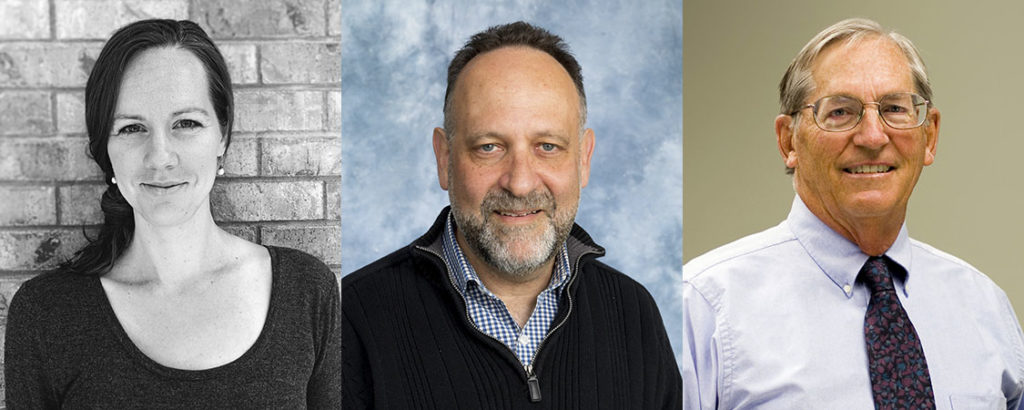
Three Colorado State University atmospheric scientists have been recognized by the American Geophysical Union. Associate Professor Elizabeth Barnes was selected for the James B. Macelwane Medal, Senior Research Scientist Paul DeMott has been elected a Fellow, and Professor Emeritus Wayne Schubert was chosen to deliver the Jule Gregory Charney Lecture. They will be honored at the AGU Fall Meeting Dec. 15 in New Orleans, Louisiana.
Early-career excellence
Barnes will receive the Macelwane Medal for “significant contributions to the geophysical sciences by an outstanding early career scientist.” Along with the medal, the AGU also will confer fellowship to Barnes.
Clara Deser, a senior scientist and head of the Climate Analysis Section at the National Center for Atmospheric Research, nominated Barnes for the medal.
“Dr. Elizabeth Barnes is an exceptionally gifted atmospheric dynamicist, who is innovating the application of emerging tools in data science to uncover new insights into the physics of the climate system,” Deser wrote for the award citation.
Barnes’ research focuses on atmospheric dynamics and variability under different climates, including subseasonal-to-seasonal prediction of extreme weather and the impacts of anthropogenic climate change. The past few years she also has focused on the data analysis tools themselves by applying new techniques in statistics and machine learning to advance climate research.
“I have been having so much fun the past few years thinking about the intersection of climate science and data science,” Barnes said. “It makes me incredibly happy that others seem to agree that this stuff is cool too!”
AGU medals are the highest honors bestowed by the union. They recognize scientists for their body of work and sustained impact within the Earth and space science community.
“It is amazing to be listed among the others who won this award before me,” Barnes said.
In 2019, Barnes received the Meisinger Award from the American Meteorological Society, and last year she was selected for the AGU Turco Lectureship, both highly competitive, national awards for fundamental contributions to climate system science.
DeMott’s work ‘groundbreaking and influential’
DeMott, an international leader in the study of ice nucleation and aerosol-cloud interactions, was elected an AGU Fellow for his research achievements and outstanding contributions to the field.
“Paul’s work has been truly groundbreaking and influential,” said University Distinguished Professor Sonia Kreidenweis, who has been a close collaborator of DeMott’s for many years. “His work has helped define both the sources of ice-nucleating particles and their roles in regional and global climate, especially in how they affect cloud microphysics and precipitation.”
In addition to his significant scientific contributions, DeMott has innovated measurement technologies and mentored many early-career scientists.
“I am happy to have been nominated by my close colleagues and to know that the wider community has valued my efforts and those of our team,” DeMott said. “It reinforces my gratitude to those who have supported me, and those who have collaborated with us over many years.”
AGU Fellows are vetted by a committee of their peers and selected based on their scientific eminence in the Earth and space sciences. Since 1962, AGU has elected fewer than 0.1% of its membership to join this prestigious group.
“I want to recognize and thank our CSU research team, past and present, who I have been lucky to be surrounded by and work with,” DeMott said.
DeMott also was inducted as an American Meteorological Society Fellow in 2019.
Making the complex understandable
The Charney Lecture is presented to a prominent scientist who has made exceptional contributions to the understanding of weather and climate. Schubert, now retired from teaching but not research after 47 years with the department, has made pioneering discoveries in his research of tropical cyclones, moist convection, and the dynamics of mesoscale and synoptic-scale phenomena.
NOAA scientist George Kiladis nominated Schubert for the Charney Lecture.
“The investigations led by Wayne into [hurricane] features transformed CSU into a leading center in the theory and modeling of tropical storms,” Kiladis wrote in his nomination letter. “To an uncommon degree, Wayne has an ability to take any topic, no matter how complex, and make it first understandable in words before solving it analytically, which is yet another reason that he has contributed so much to our field.”
In 2016, the American Meteorological Society gave Schubert the Jule G. Charney Medal, one of the organization’s top awards. He also was recognized with a named symposium at the AMS Centennial Meeting in 2020.
“It is an honor to be asked to give this lecture at the upcoming AGU meeting,” Schubert said. “I would like to thank those who nominated me for this lecture.”
Charney was a key figure in developing weather prediction, and Schubert intends to pay tribute to the late meteorologist’s fundamental contributions during his lecture.
“In this year’s talk, we shall explore the influence of Charney’s ideas and the discovery of many new phenomena unknown to him,” Schubert said.
Two other Atmospheric Science faculty members have given the Charney Lecture: Professor David Thompson in 2005 and Professor Emeritus Graeme Stephens in 2011.